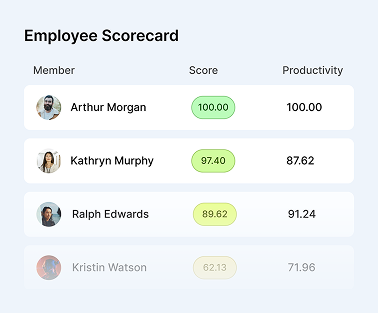Understanding Time Card Fraud: Tips for Identifying and Preventing Workplace Time Theft

Time card fraud happens when employees misreport their working hours to get paid for time they didn’t actually work. This can include logging hours when they weren’t on-site, making unjustified changes to time cards, or logging overtime that doesn’t match workload demands.
Other warning signs include buddy punching—when one employee clocks in or out for another—and suspicious patterns like always clocking out at the same time.
Spotting these red flags early helps maintain fairness and prevents losses in productivity and payroll.
Common Methods of Time Card Fraud
Time card fraud can take various forms, each with its own set of tactics for manipulating the recording of work hours. Here are some of the most prevalent methods employees may use to commit time theft:
- Buddy Punching: This occurs when a coworker clocks in or out for another employee who is not present at work.
- Ghost Employees: Payroll includes individuals who do not actually work for the company, often facilitated by someone inside the organization.
- Manual Time Sheet Alterations: Employees may falsify their own handwritten time records to reflect hours not actually worked.
- Unauthorized Overtime: Claiming overtime without approval or when no extra work has been performed.
Each method represents a unique challenge for employers and requires specific strategies to detect and prevent. Understanding these common tactics is the first step in safeguarding against time card fraud.
Consequences of Time Card Fraud
Time card fraud can have serious repercussions for both employees and employers. The consequences range from financial losses to legal actions, and can severely damage the trust within a workplace.
For employees, engaging in time card fraud can lead to:
- Disciplinary action up to and including termination
- Legal consequences, such as fines or criminal charges
- Damage to professional reputation and future employment prospects
Employers face their own set of challenges as a result of time card fraud:
- Financial losses due to overpayment of wages
- Legal penalties if found complicit or negligent in preventing fraud
- Erosion of workplace morale and trust among employees
It’s crucial for organizations to recognize the potential impact of time card fraud and take proactive steps to mitigate these risks.
Preventing Workplace Time Theft

1. Implementing Time Tracking Software
The adoption of time tracking software is a pivotal step in mitigating time card fraud. By automating the timekeeping process, businesses can significantly reduce the opportunity for manual manipulation of time records. Modern time tracking solutions offer features such as biometric verification and real-time attendance monitoring, which help ensure that the recorded time is accurate and corresponds to the actual hours worked by employees.
When selecting a time tracking system, it’s important to consider the specific needs of your organization. Below is a list of key factors to evaluate:
- Ease of Use: The software should be user-friendly to encourage compliance among employees.
- Integration Capabilities: It must seamlessly integrate with your existing payroll and HR systems.
- Customization: The ability to customize the software to fit your company’s unique workflow is crucial.
- Support and Training: Adequate support and training resources should be provided to ensure smooth implementation and usage.
Once a system is chosen, a phased rollout can help with a smooth transition. Start with a pilot program in one department before expanding to the entire organization. This approach allows for adjustments to be made based on feedback and for addressing any unforeseen challenges. Regular training sessions and support will also aid in the adoption of the new system, making it a part of the daily routine for all employees.
2. Enhancing Accountability with Screenshots
Incorporating screenshots into the monitoring process can significantly enhance employee accountability. Screenshots provide tangible evidence of activity during work hours, making it easier to address issues of time theft directly. This method is not about invasion of privacy, but about ensuring that company time is respected and well-utilized.
Monitask offers a feature that takes periodic screenshots, which can be reviewed by managers to confirm that employees are focused on their tasks. This feature can be customized to capture screens at varying intervals, depending on the level of oversight required.
- Randomized Intervals: Avoids predictability in screenshot capture.
- User Notification: Employees are informed when a screenshot is taken.
- Privacy Settings: Ability to blur sensitive information.
3. Establishing Clear Timekeeping Policies
Clear timekeeping policies are essential in preventing time card fraud and ensuring that employees understand the expectations regarding their work hours and attendance. These policies should be detailed, accessible, and consistently enforced to avoid any ambiguity that could lead to time theft.
- Policy Accessibility: Ensure that all employees have easy access to timekeeping policies. This could be through an employee handbook, intranet, or posted in common areas.
- Detailing Expectations: Clearly outline the start and end times, break periods, overtime procedures, and the process for reporting time. This eliminates confusion and provides a reference for both employees and supervisors.
- Consistency in Enforcement: Apply the policies uniformly across all departments and levels of staff. Inconsistencies can lead to perceptions of unfairness and undermine the policy’s effectiveness.
- Updating Policies: Regularly review and update the policies to reflect any changes in labor laws or company practices. Keeping policies current is crucial for compliance and relevance.
By establishing and maintaining clear timekeeping policies, organizations can create a transparent environment that discourages time card fraud and promotes an ethical workplace culture.
4. Conducting Regular Audits
Regular audits are a critical component in the fight against time card fraud. They serve as both a deterrent and a method for early detection of fraudulent activities. Audits should be conducted unpredictably to avoid giving employees the chance to prepare for them. However, the frequency of these audits should be sufficient to ensure a consistent presence of oversight.
The process of auditing can be broken down into several key steps:
- Reviewing time card records: Examine the records for any inconsistencies or patterns that suggest manipulation.
- Interviewing employees: Sometimes, discussions with employees can reveal discrepancies or misunderstandings regarding time reporting.
- Analyzing data trends: Look for trends that might indicate fraudulent behavior, such as repeated late clock-ins or early clock-outs.
- Cross-referencing with other data: Compare time cards with access logs, project timelines, and other relevant information to confirm the accuracy of reported hours.
The outcome of these audits should be documented meticulously, and any findings of misconduct must be addressed promptly. This not only helps in rectifying the current issues but also reinforces the seriousness with which the organization treats time card fraud.
Maximize productivity of your business
Track employee productivity and simplify work with them
Training Employees on Timekeeping Practices

Educating on Time Reporting Accuracy
Ensuring that employees accurately report their working hours is crucial for maintaining fair labor practices and financial integrity. Education on time reporting accuracy begins with clear communication about the importance of honest timekeeping and its impact on the organization.
Employees should be trained on how to properly use time tracking systems, whether they are digital or paper-based. This includes understanding the process for clocking in and out, recording breaks, and accounting for overtime. A step-by-step guide or checklist can be helpful for employees to reference:
- Clock in at the start of your shift.
- Record your break times accurately.
- Clock out at the end of your shift.
- Report any discrepancies or issues immediately.
Regular training sessions can reinforce these practices and provide an opportunity for employees to ask questions and clarify any uncertainties. It’s also beneficial to explain the repercussions of inaccurate time reporting, both for the individual and the organization, to underscore the seriousness of the matter.
Emphasizing Accountability in Time Tracking
Accountability in time tracking is crucial for maintaining an honest and efficient workplace. When employees understand that their timekeeping is not only a reflection of their personal integrity but also a matter of company policy, they are more likely to adhere to the rules and report their hours accurately.
To foster a culture of accountability, employers can:
- Set clear expectations: Clearly communicate the importance of accurate time tracking and the impact of time card fraud on the organization.
- Provide proper training: Ensure that all employees are trained on how to use time tracking systems correctly.
- Assign responsibility: Designate team leaders or managers to oversee timekeeping practices and address any discrepancies promptly.
- Encourage self-monitoring: Empower employees to check their own time cards for errors and report any inconsistencies.
By taking these steps, organizations can help prevent time card fraud and promote a responsible work environment where everyone plays a part in upholding timekeeping standards.
Providing Resources for Time Management
Empowering employees with the right tools and resources is crucial for effective time management. By offering access to time management courses, workshops, and seminars, employers can help staff develop the skills needed to manage their work hours efficiently.
Additionally, providing a list of recommended tools can guide employees towards better time tracking practices:
- Time management apps (e.g., Monitask, RescueTime)
- Project management software (e.g., Asana, Trello)
- Calendar apps for scheduling (e.g., Google Calendar, Outlook)
Encouraging the use of these resources not only aids in accurate time reporting but also contributes to overall productivity. Employers should also consider creating an internal repository of tips and best practices for time management, which can be regularly updated and easily accessed by all team members.
Conclusion: Preventing Time Card Fraud in the Workplace
Time card fraud is more than just a minor infraction—it can lead to significant financial losses and erode trust within a team. When left unchecked, it undermines productivity, morale, and overall organizational integrity.
Employers can combat this challenge by adopting proactive strategies such as using digital or biometric time tracking tools, setting clear attendance policies, and regularly auditing time records. These steps not only help detect inconsistencies but also discourage dishonest behavior before it starts.
Ultimately, maintaining a culture of accountability is essential. By staying vigilant and leveraging the right tools, businesses can protect their resources and foster a workplace built on transparency and fairness.
– The Monitask Team
FAQ: Time Card Fraud
How can employers recognize signs of time card fraud?
Employers can recognize signs of time card fraud by monitoring inconsistencies in time entries, frequent adjustments to time records, unauthorized overtime hours, and patterns of clocking in and out that seem unusual.
What are the common methods used in time card fraud?
Common methods of time card fraud include buddy punching, where employees clock in or out for each other, falsifying hours worked, manipulating time tracking systems, and claiming hours not actually worked.
What are the consequences of time card fraud for businesses?
The consequences of time card fraud for businesses can include financial losses, decreased productivity, damage to employee morale, legal implications, and reputational damage to the company.
How can employers prevent workplace time theft through time tracking software?
Employers can prevent workplace time theft by implementing time tracking software that records clock-in and clock-out times, tracks breaks and meal periods, and provides accurate data for payroll processing and auditing.
Why is establishing clear timekeeping policies important in preventing time card fraud?
Establishing clear timekeeping policies is important in preventing time card fraud because it sets expectations for employees, outlines consequences for violations, and establishes a transparent and fair system for tracking work hours.



